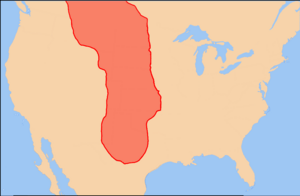Plano cultures facts for kids

Map of the Great Plains region
|
|
| Geographical range | Great Plains |
|---|---|
| Period | Archaic |
| Dates | 9000 – 6000 BCE |
| Preceded by | Paleo-Indians |
| Followed by | Old Copper Complex |
The Plano cultures were groups of ancient people who lived in North America, mostly in the Great Plains area. These people were hunter-gatherers, meaning they hunted animals and gathered plants for food. They lived during a time called the Paleo-Indian or Archaic period.
Contents
Plano Cultures: Ancient Hunters of the Plains
The Plano cultures are known for their special tools, especially their spear points. These tools are called Plano points. Unlike some older tools, Plano points were "unfluted," meaning they didn't have a groove or channel removed from their base.
What Made Them Special?
These ancient people were very skilled hunters. They often hunted large animals like Bison antiquus, which was a type of ancient bison. They used clever ways to hunt, like scaring herds of bison to run off cliffs or into corrals (pens).
Their diet wasn't just bison. They also hunted other animals such as pronghorn, elk, deer, raccoon, and coyote. To make sure they had food for later, they preserved meat. They would mix meat with berries and animal fat, then store it in containers made from animal hides.
A Look Back in Time: Their History
The Plano cultures lived in North America between about 9000 BCE and 6000 BCE. That's a very long time ago! They started in the plains but spread out a lot. Their communities reached from the Atlantic coast all the way to what is now British Columbia, and even north into the Northwest Territories.
Early Plano groups lived south of the North Saskatchewan River in Saskatchewan. They also lived in the foothills of the Rocky Mountains. At that time, much of Manitoba was still covered by a huge ancient lake called Glacial Lake Agassiz and ice from glaciers.
As the glaciers melted around 9,000 years ago, new areas opened up. Plants and animals began to spread north and east. This changed what the Plano people hunted. In the colder tundra areas, they hunted barren-ground caribou. In the forests, they hunted boreal woodland caribou and mountain caribou. These caribou became more important than bison in many areas.
Different Groups of Plano People
In the Great Plains, there were several different Plano cultures between 10,000 and 7,000 years ago. Each group had its own unique style of long, lanceolate (lance-shaped) spear points. Some of these groups include:
- Agate Basin complex: Named after the Agate Basin Site.
- Cody complex: Named after the Horner site near Cody, Wyoming. This group is linked to important sites like the Olsen-Chubbuck Bison Kill Site and the Jurgens Site.
- Hell Gap complex: Named after the Hell Gap site in Wyoming. The Jones-Miller Bison Kill Site is also connected to this group.
- Foothills / Mountain complex

